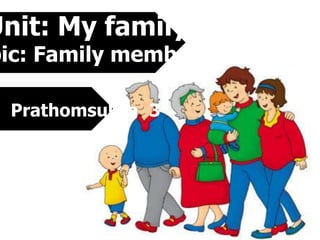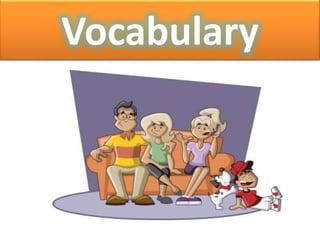ppt.
Download as pptx, pdf0 likes294 views
My family consists of my mother, father, and younger brother. We enjoy spending time together on weekends going to the park, watching movies, and cooking meals in our home. As a family, we support each other through both good and challenging times.
1 of 19
Download to read offline



















Ad
Recommended
CLIL : calendar
CLIL : calendarSerena Sunisa
╠²
This document provides information about using calendars, including:
- The structure of a calendar showing the months and number of days in each month.
- How to find the day of the week that a given date falls on.
- Examples of writing out dates in the day-month-year format and stating the day of the week.
- That calendars can be used to find the number of weeks between dates and to mark important events like birthdays.Ó╣üÓĖ£ÓĖ╚©ĖüÓĖ▓ÓĖŻÓ╣Č─ÓĖéÓĖĄÓĖóÓĖÖ
Ó╣üÓĖ£ÓĖ╚©ĖüÓĖ▓ÓĖŻÓ╣Č─ÓĖéÓĖĄÓĖóÓĖÖSerena Sunisa
╠²
The document provides information about 4 writing activities:
1. Activity 1 has students make sentences using present simple tense and provided vocabulary.
2. Activity 2 involves students writing descriptions to accompany pictures.
3. Activity 3 is a game where students write clues about types of cake for their teammates to guess.
4. Activity 4 tasks students with writing postcards providing information about international foods.reading skill
reading skillSerena Sunisa
╠²
The Christ of the Abyss statue is a 2.5 meter tall bronze statue of Jesus located 17 meters underwater off the coast of Italy. It was placed there in 1954 to commemorate the first Italian scuba diver. Various other copies of the statue have been placed in other locations around the world, both underwater and on land.PPP unit career
PPP unit career Serena Sunisa
╠²
The document discusses future career plans and interests after graduating from high school. It mentions being interested in careers in the music business such as managing musicians or the travel business as a tour guide. It also provides vocabulary about infinitives and gerunds and includes a sample conversation about career interests.Ppp Ó╣ĆÓĖéÓĖĄÓĖóÓĖÖ
Ppp Ó╣ĆÓĖéÓĖĄÓĖóÓĖÖ Serena Sunisa
╠²
This document provides information on popular national dishes from several countries. It describes the hamburger from the United States, noting that Louis' Lunch in Connecticut is considered the oldest hamburger restaurant. It also discusses Wiener Schnitzel from Austria, made from veal cutlets breaded and fried. Pot-au-feu from France is described as a hearty stew. Roast beef and Yorkshire pudding from England is highlighted as a Sunday lunch symbol, traditionally served with gravy soaked potatoes and vegetables. Information and recommendations for trying authentic versions of each dish are provided.ÓĖäÓĖŻÓĖ▒Ó╣ēÓĖćÓĖŚÓĖĄÓ╣ł 1
ÓĖäÓĖŻÓĖ▒Ó╣ēÓĖćÓĖŚÓĖĄÓ╣ł 1Serena Sunisa
╠²
My family consists of my mother, father, and younger brother. We enjoy spending time together on weekends going to the park, watching movies, and cooking meals in our home. As a family, we support each other through both good and challenging times.CBI
CBISerena Sunisa
╠²
1. The document describes a teaching unit on the life and death cycle of stars.
2. It includes two texts and a video on the topic, as well as two classroom activities - Activity 1 involves a true/false quiz on the life of stars, and Activity 2 tests students' understanding of subject-verb agreement rules.
3. The teaching procedures section outlines how the instructor will guide students through the power point presentations, texts and activities to teach them about the different stages of a star's life and key astronomy concepts.Speaking Skill ppt.
Speaking Skill ppt.Serena Sunisa
╠²
This document provides information about famous people from movies. It includes vocabulary words related to fame, a short video, questions about the video, and an activity where students discuss famous actors and have to identify them from pictures. The document covers famous actors from the Twilight and Harry Potter film franchises like Taylor Lautner, Robert Pattinson, Kristen Stewart, Ashley Greene, Daniel Radcliffe, Emma Watson, and Rupert Grint. It provides exercises for students to demonstrate their understanding of these famous people.Speaking Skill
Speaking SkillSerena Sunisa
╠²
The document provides instructions for teaching students about famous people through various classroom speaking activities. It begins with pre-speaking questions to introduce the topic. It then outlines 4 main activities:
1. Activity 1 involves students brainstorming in groups about famous people and presenting to the class.
2. Activity 2 has students discuss their favorite famous person in more detail.
3. Activity 3 is a game where students identify photos of famous faces.
4. Activity 4 assigns each student a famous person and has them conduct an interview role-play with a partner.
The document concludes with examples of how the role-play activity might be carried out, as well as references used in developing the lesson plan.Listening skill
Listening skillSerena Sunisa
╠²
This document contains information about a lesson on family members. It includes 4 listening activities: 1) Choose the correct answer, 2) Identify the correct picture, 3) Draw a picture of the student's family, and 4) Identify family members. It also includes vocabulary about family relationships and the structure of singular and plural nouns. Sample conversations are provided to accompany the listening activities. Key information is presented through power points, audio recordings, and examples. The purpose is to teach English language learners about family vocabulary and grammar through interactive listening exercises.Ptt ÓĖäÓĖōÓĖ┤ÓĖĢÓĖ©ÓĖ▓ÓĖ¬ÓĖĢÓĖŻÓ╣ī(canlendar)
Ptt ÓĖäÓĖōÓĖ┤ÓĖĢÓĖ©ÓĖ▓ÓĖ¬ÓĖĢÓĖŻÓ╣ī(canlendar)Serena Sunisa
╠²
This document provides information about calendars and months. It lists the 12 months of the year in order from January to December. It also lists the days of the week and provides some examples of how to write dates. The text then presents some starter activities and challenges for readers related to finding birthdays and calculating time periods between dates using a calendar.Ptt ÓĖäÓĖōÓĖ┤ÓĖĢÓĖ©ÓĖ▓ÓĖ¬ÓĖĢÓĖŻ(canlendar)
Ptt ÓĖäÓĖōÓĖ┤ÓĖĢÓĖ©ÓĖ▓ÓĖ¬ÓĖĢÓĖŻ(canlendar)Serena Sunisa
╠²
This document provides information about calendars and months. It lists the 12 months of the year in order and notes that February is the second month and December is the last month. It also lists the days of the week and provides instruction on using the present simple tense in English. The document concludes with sample calendar activities including writing out dates, finding birthdays, and determining which half of the year has more birthdays.Nest building.docx
Nest building.docxSerena Sunisa
╠²
Mr. Hatch was looking for his gloves that he had last worn in the garden. He found one glove but not the other. He later saw a robin take the missing glove to line its nest. Mr. Hatch didn't want to take the glove back since it was keeping the nest warm. He tried to find something else that would keep the nest just as warm for the robin.Text nest building
Text nest buildingSerena Sunisa
╠²
Mr. Hatch was preparing to go shopping and needed his warm scarf and gloves due to the frosty weather. He remembered last wearing them in the garden last week and found his scarf and one glove by the wheelbarrow. A robin then flew down and took the missing glove to line its nest for warmth during the winter. Mr. Hatch needed his gloves but also wanted to keep the robin warm, so he considered finding something else to line the nest.CBI ppt.
CBI ppt.Serena Sunisa
╠²
This document appears to be a student's report card for Matthayomsuksa 5 (grade 11) in Thailand. It evaluates the student in three subjects: speaking, reading, and writing. The student received higher marks in reading than their other subjects, as reading is listed first among the three evaluations.CBI
CBISerena Sunisa
╠²
1. The document describes a teaching unit on the life and death cycle of stars.
2. It includes two texts and a video on the topic, as well as two classroom activities - Activity 1 involves a true/false quiz on the life of stars, and Activity 2 tests students' understanding of subject-verb agreement rules.
3. The teaching procedures section outlines how the instructor will guide students through the power point presentations, texts and activities to teach them about the different stages of a star's life and key astronomy concepts. B slim ppt.
B slim ppt.Serena Sunisa
╠²
The document discusses different seasons and weather terms. It defines weather as the condition of the atmosphere including temperature, wind, and precipitation. It lists the four seasons - spring, summer, fall, and winter - and provides adjectives to describe hot, cold, and freezing temperatures. It also discusses the use of comparative and superlative adjectives such as hottest, coldest, and best.Communicable Diseases and National Health Programs ŌĆō Unit 9 | B.Sc Nursing 5t...
Communicable Diseases and National Health Programs ŌĆō Unit 9 | B.Sc Nursing 5t...RAKESH SAJJAN
╠²
This PowerPoint presentation covers Unit 9 ŌĆō Communicable Diseases and National Health Programs, a core part of the 5th Semester B.Sc Nursing (Community Health Nursing ŌĆō I) syllabus, as outlined by the Indian Nursing Council (INC).
This unit enables nursing students to understand the epidemiology, prevention, control, and nursing management of common communicable diseases in India, while also offering a structured overview of the National Health Programs implemented to address them.
The content is critical for effective field practice, disease surveillance, early detection, referral, and health education, equipping students to participate in public health interventions and outbreak control at community and national levels.
¤ōś Key Topics Covered in the PPT:
Definition and classification of communicable diseases
Modes of transmission and chain of infection
Common communicable diseases in India:
Malaria
Tuberculosis
Leprosy
Dengue
HIV/AIDS
Hepatitis
COVID-19 (if included in the current curriculum)
Diarrheal diseases
Acute Respiratory Infections (ARIs)
Epidemiological factors, causative agents, symptoms, and incubation periods
Prevention and control strategies: primary, secondary, and tertiary levels
Nursing responsibilities in patient care, contact tracing, community surveillance, and outbreak control
Health education and behavior change communication for community awareness
Vaccination schedules and cold chain maintenance
National Health Programs related to communicable diseases:
National Vector Borne Disease Control Program (NVBDCP)
Revised National Tuberculosis Control Program (RNTCP)
National Leprosy Eradication Program (NLEP)
National AIDS Control Program (NACP)
Universal Immunization Program (UIP)
IDSP ŌĆō Integrated Disease Surveillance Program
Overview of standard treatment protocols, referral mechanisms, and community nurseŌĆÖs role in program implementation
This presentation is ideal for:
Nursing students preparing for university exams, class tests, and field projects
Tutors teaching infectious disease nursing and public health interventions
Nurses involved in immunization, outbreak investigation, and contact tracing
It provides a student-friendly breakdown of concepts, aligned with national priorities, including flowcharts, tables, case examples, and simplified text for field-level application.ABCs of Bookkeeping for Nonprofits TechSoup.pdf
ABCs of Bookkeeping for Nonprofits TechSoup.pdfTechSoup
╠²
Accounting can be hard enough if you havenŌĆÖt studied it in school. Nonprofit accounting is actually very different and more challenging still.
Need help? Join Nonprofit CPA and QuickBooks expert Gregg Bossen in this first-time webinar and learn the ABCs of keeping books for a nonprofit organization.
Key takeaways
* What accounting is and how it works
* How to read a financial statement
* What financial statements should be given to the board each month
* What three things nonprofits are required to track
What features to use in QuickBooks to track programs and grantsBINARY files CSV files JSON files with example.pptx
BINARY files CSV files JSON files with example.pptxRamakrishna Reddy Bijjam
╠²
BINARY FILES, CSV FILES2025 June Year 9 Presentation: Subject selection.pptx
2025 June Year 9 Presentation: Subject selection.pptxmansk2
╠²
2025 June Year 9 Presentation: Subject selectionSCHIZOPHRENIA OTHER PSYCHOTIC DISORDER LIKE Persistent delusion/Capgras syndr...
SCHIZOPHRENIA OTHER PSYCHOTIC DISORDER LIKE Persistent delusion/Capgras syndr...parmarjuli1412
╠²
SCHIZOPHRENIA INCLUDED TOPIC IS INTRODUCTION, DEFINITION OF GENERAL TERM IN PSYCHIATRIC, THEN DIFINITION OF SCHIZOPHRENIA, EPIDERMIOLOGY, ETIOLOGICAL FACTORS, CLINICAL FEATURE(SIGN AND SYMPTOMS OF SCHIZOPHRENIA), CLINICAL TYPES OF SCHIZOPHRENIA, DIAGNOSIS, INVESTIGATION, TREATMENT MODALITIES(PHARMACOLOGICAL MANAGEMENT, PSYCHOTHERAPY, ECT, PSYCHO-SOCIO-REHABILITATION), NURSING MANAGEMENT(ASSESSMENT,DIAGNOSIS,NURSING INTERVENTION,AND EVALUATION), OTHER PSYCHOTIC DISORDER LIKE Persistent delusion/Capgras syndrome(The Delusion of Doubles)/Acute and Transient Psychotic Disorders/Induced Delusional Disorders/Schizoaffective Disorder /CAPGRAS SYNDROME(DELUSION OF DOUBLE), GERIATRIC CONSIDERATION, FOLLOW UP, HOMECARE AND REHABILITATION OF THE PATIENT, Health Care Planning and Organization of Health Care at Various Levels ŌĆō Unit...
Health Care Planning and Organization of Health Care at Various Levels ŌĆō Unit...RAKESH SAJJAN
╠²
This comprehensive PowerPoint presentation is prepared for B.Sc Nursing 5th Semester students and covers Unit 2 of Community Health Nursing ŌĆō I based on the Indian Nursing Council (INC) syllabus. The unit focuses on the planning, structure, and functioning of health care services at various levels in India. It is especially useful for nursing educators and students preparing for university exams, internal assessments, or professional teaching assignments.
The content of this presentation includes:
Historical development of health planning in India
Detailed study of various health committees: Bhore, Mudaliar, Kartar Singh, Shrivastava Committee, etc.
Overview of major health commissions
In-depth understanding of Five-Year Plans and their impact on health care
Community participation and stakeholder involvement in health care planning
Structure of health care delivery system at central, state, district, and peripheral levels
Concepts and implementation of Primary Health Care (PHC) and Sustainable Development Goals (SDGs)
Introduction to Comprehensive Primary Health Care (CPHC) and Health and Wellness Centers (HWCs)
Expanded role of Mid-Level Health Providers (MLHPs) and Community Health Providers (CHPs)
Explanation of national health policies: NHP 1983, 2002, and 2017
Key national missions and schemes including:
National Health Mission (NHM)
National Rural Health Mission (NRHM)
National Urban Health Mission (NUHM)
Ayushman Bharat ŌĆō Pradhan Mantri Jan Arogya Yojana (PM-JAY)
Universal Health Coverage (UHC) and IndiaŌĆÖs commitment to equitable health care
This presentation is ideal for:
Nursing students (B.Sc, GNM, Post Basic)
Nursing tutors and faculty
Health educators
Competitive exam aspirants in nursing and public health
It is organized in a clear, point-wise format with relevant terminologies and a focus on applied knowledge. The slides can also be used for community health demonstrations, teaching sessions, and revision guides.Battle of Bookworms 2025 - U25 Literature Quiz by Pragya
Battle of Bookworms 2025 - U25 Literature Quiz by Pragya Pragya - UEM Kolkata Quiz Club
╠²
Battle of Bookworms is a literature quiz organized by Pragya, UEM Kolkata, as part of their cultural fest Ecstasia. Curated by quizmasters Drisana Bhattacharyya, Argha Saha, and Aniket Adhikari, the quiz was a dynamic mix of classical literature, modern writing, mythology, regional texts, and experimental literary forms. It began with a 20-question prelim round where ŌĆśstar questionsŌĆÖ played a key tie-breaking role. The top 8 teams moved into advanced rounds, where they faced audio-visual challenges, pounce/bounce formats, immunity tokens, and theme-based risk-reward questions. From Orwell and Hemingway to Tagore and Sarala Das, the quiz traversed a global and Indian literary landscape. Unique rounds explored slipstream fiction, constrained writing, adaptations, and true crime literature. It included signature IDs, character identifications, and open-pounce selections. Questions were crafted to test contextual understanding, narrative knowledge, and authorial intent, making the quiz both intellectually rewarding and culturally rich. Battle of Bookworms proved literature quizzes can be insightful, creative, and deeply enjoyable for all.LDMMIA Practitioner Level Orientation Updates
LDMMIA Practitioner Level Orientation UpdatesLDM & Mia eStudios
╠²
See our 2 Starter PDFs within a Compressed, Zip Drive. Within Shop. Videos will be available Before the Weekend of 6/14th. For the US, Happy Fathers Day Weekend. (Our readers/teams are global.) Also, our content remains timeless for Future Grad Students seeking updates.
After about a Year or 10, I retire older content. Literally up to under 10 yrs. We will be 19 yrs old this Aug for Love and Divinity in Motion (LDM). How old are we? So funny. Our oldest profile is X, formerly Twitter. From our old Apple Podcast Years.
https://ldm-mia.creator-spring.com
Session/Lesson 1 -Intro
REIKI- YOGA ŌĆ£ORIENTATIONŌĆØ
It helps to understand the text behind anything. This improves our performance and confidence.
Your training will be mixed media. Includes Rehab Intro and Meditation vods, all sold separately.
Editing our Vods & New Shop. Retail under $30 per item.
*Store Fees will apply. *Digital Should be low cost.
Thank you for attending our free workshops. Those can be used with any Reiki Yoga training package. Traditional Reiki does host rules and ethics. Its silent and within the JP Culture/Area/Training/Word of Mouth. It allows remote healing but thereŌĆÖs limits for practitioners and masters. We are not allowed to share certain secrets/tools. Some content is designed only for ŌĆ£MastersŌĆØ...
Next Upload will be our Video package for Session 1. Prices will be affordable as possible. Thx for becoming a "Practitioner Level" Student.
Updates so far, are every week for spring. Summer should be a similar schedule. Thx for visitings, attending, and following LDMMIA.
Social Media:
https://x.com/OnlineDrLeZ
and
https://www.instagram.com/chelleofsl/
University of Ghana Cracks Down on Misconduct: Over 100 Students Sanctioned
University of Ghana Cracks Down on Misconduct: Over 100 Students SanctionedKweku Zurek
╠²
University of Ghana Cracks Down on Misconduct: Over 100 Students Sanctioned
ECONOMICS, DISASTER MANAGEMENT, ROAD SAFETY - STUDY MATERIAL [10TH]
ECONOMICS, DISASTER MANAGEMENT, ROAD SAFETY - STUDY MATERIAL [10TH]SHERAZ AHMAD LONE
╠²
This study material for Class 10th covers the core subjects of Economics, Disaster Management, and Road Safety Education, developed strictly in line with the JKBOSE textbook. It presents the content in a simplified, structured, and student-friendly format, ensuring clarity in concepts. The material includes reframed explanations, flowcharts, infographics, and key point summaries to support better understanding and retention. Designed for classroom teaching and exam preparation, it aims to enhance comprehension, critical thinking, and practical awareness among students.More Related Content
More from Serena Sunisa (11)
Speaking Skill
Speaking SkillSerena Sunisa
╠²
The document provides instructions for teaching students about famous people through various classroom speaking activities. It begins with pre-speaking questions to introduce the topic. It then outlines 4 main activities:
1. Activity 1 involves students brainstorming in groups about famous people and presenting to the class.
2. Activity 2 has students discuss their favorite famous person in more detail.
3. Activity 3 is a game where students identify photos of famous faces.
4. Activity 4 assigns each student a famous person and has them conduct an interview role-play with a partner.
The document concludes with examples of how the role-play activity might be carried out, as well as references used in developing the lesson plan.Listening skill
Listening skillSerena Sunisa
╠²
This document contains information about a lesson on family members. It includes 4 listening activities: 1) Choose the correct answer, 2) Identify the correct picture, 3) Draw a picture of the student's family, and 4) Identify family members. It also includes vocabulary about family relationships and the structure of singular and plural nouns. Sample conversations are provided to accompany the listening activities. Key information is presented through power points, audio recordings, and examples. The purpose is to teach English language learners about family vocabulary and grammar through interactive listening exercises.Ptt ÓĖäÓĖōÓĖ┤ÓĖĢÓĖ©ÓĖ▓ÓĖ¬ÓĖĢÓĖŻÓ╣ī(canlendar)
Ptt ÓĖäÓĖōÓĖ┤ÓĖĢÓĖ©ÓĖ▓ÓĖ¬ÓĖĢÓĖŻÓ╣ī(canlendar)Serena Sunisa
╠²
This document provides information about calendars and months. It lists the 12 months of the year in order from January to December. It also lists the days of the week and provides some examples of how to write dates. The text then presents some starter activities and challenges for readers related to finding birthdays and calculating time periods between dates using a calendar.Ptt ÓĖäÓĖōÓĖ┤ÓĖĢÓĖ©ÓĖ▓ÓĖ¬ÓĖĢÓĖŻ(canlendar)
Ptt ÓĖäÓĖōÓĖ┤ÓĖĢÓĖ©ÓĖ▓ÓĖ¬ÓĖĢÓĖŻ(canlendar)Serena Sunisa
╠²
This document provides information about calendars and months. It lists the 12 months of the year in order and notes that February is the second month and December is the last month. It also lists the days of the week and provides instruction on using the present simple tense in English. The document concludes with sample calendar activities including writing out dates, finding birthdays, and determining which half of the year has more birthdays.Nest building.docx
Nest building.docxSerena Sunisa
╠²
Mr. Hatch was looking for his gloves that he had last worn in the garden. He found one glove but not the other. He later saw a robin take the missing glove to line its nest. Mr. Hatch didn't want to take the glove back since it was keeping the nest warm. He tried to find something else that would keep the nest just as warm for the robin.Text nest building
Text nest buildingSerena Sunisa
╠²
Mr. Hatch was preparing to go shopping and needed his warm scarf and gloves due to the frosty weather. He remembered last wearing them in the garden last week and found his scarf and one glove by the wheelbarrow. A robin then flew down and took the missing glove to line its nest for warmth during the winter. Mr. Hatch needed his gloves but also wanted to keep the robin warm, so he considered finding something else to line the nest.CBI ppt.
CBI ppt.Serena Sunisa
╠²
This document appears to be a student's report card for Matthayomsuksa 5 (grade 11) in Thailand. It evaluates the student in three subjects: speaking, reading, and writing. The student received higher marks in reading than their other subjects, as reading is listed first among the three evaluations.CBI
CBISerena Sunisa
╠²
1. The document describes a teaching unit on the life and death cycle of stars.
2. It includes two texts and a video on the topic, as well as two classroom activities - Activity 1 involves a true/false quiz on the life of stars, and Activity 2 tests students' understanding of subject-verb agreement rules.
3. The teaching procedures section outlines how the instructor will guide students through the power point presentations, texts and activities to teach them about the different stages of a star's life and key astronomy concepts. B slim ppt.
B slim ppt.Serena Sunisa
╠²
The document discusses different seasons and weather terms. It defines weather as the condition of the atmosphere including temperature, wind, and precipitation. It lists the four seasons - spring, summer, fall, and winter - and provides adjectives to describe hot, cold, and freezing temperatures. It also discusses the use of comparative and superlative adjectives such as hottest, coldest, and best.Recently uploaded (20)
Communicable Diseases and National Health Programs ŌĆō Unit 9 | B.Sc Nursing 5t...
Communicable Diseases and National Health Programs ŌĆō Unit 9 | B.Sc Nursing 5t...RAKESH SAJJAN
╠²
This PowerPoint presentation covers Unit 9 ŌĆō Communicable Diseases and National Health Programs, a core part of the 5th Semester B.Sc Nursing (Community Health Nursing ŌĆō I) syllabus, as outlined by the Indian Nursing Council (INC).
This unit enables nursing students to understand the epidemiology, prevention, control, and nursing management of common communicable diseases in India, while also offering a structured overview of the National Health Programs implemented to address them.
The content is critical for effective field practice, disease surveillance, early detection, referral, and health education, equipping students to participate in public health interventions and outbreak control at community and national levels.
¤ōś Key Topics Covered in the PPT:
Definition and classification of communicable diseases
Modes of transmission and chain of infection
Common communicable diseases in India:
Malaria
Tuberculosis
Leprosy
Dengue
HIV/AIDS
Hepatitis
COVID-19 (if included in the current curriculum)
Diarrheal diseases
Acute Respiratory Infections (ARIs)
Epidemiological factors, causative agents, symptoms, and incubation periods
Prevention and control strategies: primary, secondary, and tertiary levels
Nursing responsibilities in patient care, contact tracing, community surveillance, and outbreak control
Health education and behavior change communication for community awareness
Vaccination schedules and cold chain maintenance
National Health Programs related to communicable diseases:
National Vector Borne Disease Control Program (NVBDCP)
Revised National Tuberculosis Control Program (RNTCP)
National Leprosy Eradication Program (NLEP)
National AIDS Control Program (NACP)
Universal Immunization Program (UIP)
IDSP ŌĆō Integrated Disease Surveillance Program
Overview of standard treatment protocols, referral mechanisms, and community nurseŌĆÖs role in program implementation
This presentation is ideal for:
Nursing students preparing for university exams, class tests, and field projects
Tutors teaching infectious disease nursing and public health interventions
Nurses involved in immunization, outbreak investigation, and contact tracing
It provides a student-friendly breakdown of concepts, aligned with national priorities, including flowcharts, tables, case examples, and simplified text for field-level application.ABCs of Bookkeeping for Nonprofits TechSoup.pdf
ABCs of Bookkeeping for Nonprofits TechSoup.pdfTechSoup
╠²
Accounting can be hard enough if you havenŌĆÖt studied it in school. Nonprofit accounting is actually very different and more challenging still.
Need help? Join Nonprofit CPA and QuickBooks expert Gregg Bossen in this first-time webinar and learn the ABCs of keeping books for a nonprofit organization.
Key takeaways
* What accounting is and how it works
* How to read a financial statement
* What financial statements should be given to the board each month
* What three things nonprofits are required to track
What features to use in QuickBooks to track programs and grantsBINARY files CSV files JSON files with example.pptx
BINARY files CSV files JSON files with example.pptxRamakrishna Reddy Bijjam
╠²
BINARY FILES, CSV FILES2025 June Year 9 Presentation: Subject selection.pptx
2025 June Year 9 Presentation: Subject selection.pptxmansk2
╠²
2025 June Year 9 Presentation: Subject selectionSCHIZOPHRENIA OTHER PSYCHOTIC DISORDER LIKE Persistent delusion/Capgras syndr...
SCHIZOPHRENIA OTHER PSYCHOTIC DISORDER LIKE Persistent delusion/Capgras syndr...parmarjuli1412
╠²
SCHIZOPHRENIA INCLUDED TOPIC IS INTRODUCTION, DEFINITION OF GENERAL TERM IN PSYCHIATRIC, THEN DIFINITION OF SCHIZOPHRENIA, EPIDERMIOLOGY, ETIOLOGICAL FACTORS, CLINICAL FEATURE(SIGN AND SYMPTOMS OF SCHIZOPHRENIA), CLINICAL TYPES OF SCHIZOPHRENIA, DIAGNOSIS, INVESTIGATION, TREATMENT MODALITIES(PHARMACOLOGICAL MANAGEMENT, PSYCHOTHERAPY, ECT, PSYCHO-SOCIO-REHABILITATION), NURSING MANAGEMENT(ASSESSMENT,DIAGNOSIS,NURSING INTERVENTION,AND EVALUATION), OTHER PSYCHOTIC DISORDER LIKE Persistent delusion/Capgras syndrome(The Delusion of Doubles)/Acute and Transient Psychotic Disorders/Induced Delusional Disorders/Schizoaffective Disorder /CAPGRAS SYNDROME(DELUSION OF DOUBLE), GERIATRIC CONSIDERATION, FOLLOW UP, HOMECARE AND REHABILITATION OF THE PATIENT, Health Care Planning and Organization of Health Care at Various Levels ŌĆō Unit...
Health Care Planning and Organization of Health Care at Various Levels ŌĆō Unit...RAKESH SAJJAN
╠²
This comprehensive PowerPoint presentation is prepared for B.Sc Nursing 5th Semester students and covers Unit 2 of Community Health Nursing ŌĆō I based on the Indian Nursing Council (INC) syllabus. The unit focuses on the planning, structure, and functioning of health care services at various levels in India. It is especially useful for nursing educators and students preparing for university exams, internal assessments, or professional teaching assignments.
The content of this presentation includes:
Historical development of health planning in India
Detailed study of various health committees: Bhore, Mudaliar, Kartar Singh, Shrivastava Committee, etc.
Overview of major health commissions
In-depth understanding of Five-Year Plans and their impact on health care
Community participation and stakeholder involvement in health care planning
Structure of health care delivery system at central, state, district, and peripheral levels
Concepts and implementation of Primary Health Care (PHC) and Sustainable Development Goals (SDGs)
Introduction to Comprehensive Primary Health Care (CPHC) and Health and Wellness Centers (HWCs)
Expanded role of Mid-Level Health Providers (MLHPs) and Community Health Providers (CHPs)
Explanation of national health policies: NHP 1983, 2002, and 2017
Key national missions and schemes including:
National Health Mission (NHM)
National Rural Health Mission (NRHM)
National Urban Health Mission (NUHM)
Ayushman Bharat ŌĆō Pradhan Mantri Jan Arogya Yojana (PM-JAY)
Universal Health Coverage (UHC) and IndiaŌĆÖs commitment to equitable health care
This presentation is ideal for:
Nursing students (B.Sc, GNM, Post Basic)
Nursing tutors and faculty
Health educators
Competitive exam aspirants in nursing and public health
It is organized in a clear, point-wise format with relevant terminologies and a focus on applied knowledge. The slides can also be used for community health demonstrations, teaching sessions, and revision guides.Battle of Bookworms 2025 - U25 Literature Quiz by Pragya
Battle of Bookworms 2025 - U25 Literature Quiz by Pragya Pragya - UEM Kolkata Quiz Club
╠²
Battle of Bookworms is a literature quiz organized by Pragya, UEM Kolkata, as part of their cultural fest Ecstasia. Curated by quizmasters Drisana Bhattacharyya, Argha Saha, and Aniket Adhikari, the quiz was a dynamic mix of classical literature, modern writing, mythology, regional texts, and experimental literary forms. It began with a 20-question prelim round where ŌĆśstar questionsŌĆÖ played a key tie-breaking role. The top 8 teams moved into advanced rounds, where they faced audio-visual challenges, pounce/bounce formats, immunity tokens, and theme-based risk-reward questions. From Orwell and Hemingway to Tagore and Sarala Das, the quiz traversed a global and Indian literary landscape. Unique rounds explored slipstream fiction, constrained writing, adaptations, and true crime literature. It included signature IDs, character identifications, and open-pounce selections. Questions were crafted to test contextual understanding, narrative knowledge, and authorial intent, making the quiz both intellectually rewarding and culturally rich. Battle of Bookworms proved literature quizzes can be insightful, creative, and deeply enjoyable for all.LDMMIA Practitioner Level Orientation Updates
LDMMIA Practitioner Level Orientation UpdatesLDM & Mia eStudios
╠²
See our 2 Starter PDFs within a Compressed, Zip Drive. Within Shop. Videos will be available Before the Weekend of 6/14th. For the US, Happy Fathers Day Weekend. (Our readers/teams are global.) Also, our content remains timeless for Future Grad Students seeking updates.
After about a Year or 10, I retire older content. Literally up to under 10 yrs. We will be 19 yrs old this Aug for Love and Divinity in Motion (LDM). How old are we? So funny. Our oldest profile is X, formerly Twitter. From our old Apple Podcast Years.
https://ldm-mia.creator-spring.com
Session/Lesson 1 -Intro
REIKI- YOGA ŌĆ£ORIENTATIONŌĆØ
It helps to understand the text behind anything. This improves our performance and confidence.
Your training will be mixed media. Includes Rehab Intro and Meditation vods, all sold separately.
Editing our Vods & New Shop. Retail under $30 per item.
*Store Fees will apply. *Digital Should be low cost.
Thank you for attending our free workshops. Those can be used with any Reiki Yoga training package. Traditional Reiki does host rules and ethics. Its silent and within the JP Culture/Area/Training/Word of Mouth. It allows remote healing but thereŌĆÖs limits for practitioners and masters. We are not allowed to share certain secrets/tools. Some content is designed only for ŌĆ£MastersŌĆØ...
Next Upload will be our Video package for Session 1. Prices will be affordable as possible. Thx for becoming a "Practitioner Level" Student.
Updates so far, are every week for spring. Summer should be a similar schedule. Thx for visitings, attending, and following LDMMIA.
Social Media:
https://x.com/OnlineDrLeZ
and
https://www.instagram.com/chelleofsl/
University of Ghana Cracks Down on Misconduct: Over 100 Students Sanctioned
University of Ghana Cracks Down on Misconduct: Over 100 Students SanctionedKweku Zurek
╠²
University of Ghana Cracks Down on Misconduct: Over 100 Students Sanctioned
ECONOMICS, DISASTER MANAGEMENT, ROAD SAFETY - STUDY MATERIAL [10TH]
ECONOMICS, DISASTER MANAGEMENT, ROAD SAFETY - STUDY MATERIAL [10TH]SHERAZ AHMAD LONE
╠²
This study material for Class 10th covers the core subjects of Economics, Disaster Management, and Road Safety Education, developed strictly in line with the JKBOSE textbook. It presents the content in a simplified, structured, and student-friendly format, ensuring clarity in concepts. The material includes reframed explanations, flowcharts, infographics, and key point summaries to support better understanding and retention. Designed for classroom teaching and exam preparation, it aims to enhance comprehension, critical thinking, and practical awareness among students.Paper 109 | Archetypal Journeys in ŌĆśInterstellarŌĆÖ: Exploring Universal Themes...
Paper 109 | Archetypal Journeys in ŌĆśInterstellarŌĆÖ: Exploring Universal Themes...Rajdeep Bavaliya
╠²
Get ready to embark on a cosmic quest as we unpack the archetypal power behind Christopher NolanŌĆÖs ŌĆśInterstellar.ŌĆÖ Discover how heroŌĆÖs journey tropes, mythic symbols like wormholes and tesseracts, and themes of love, sacrifice, and environmental urgency shape this epic odyssey. Whether youŌĆÖre a film theory buff or a casual viewer, youŌĆÖll learn why CooperŌĆÖs journey resonates with timeless mythsŌĆöand what it means for our own future. Smash that like button, and follow for more deep dives into cinemaŌĆÖs greatest stories!
M.A. Sem - 2 | Presentation
Presentation Season - 2
Paper - 109: Literary Theory & Criticism and Indian Aesthetics
Submitted Date: April 5, 2025
Paper Name: Literary Theory & Criticism and Indian Aesthetics
Topic: Archetypal Journeys in ŌĆśInterstellarŌĆÖ: Exploring Universal Themes in NolanŌĆÖs Cosmic Odyssey
[Please copy the link and paste it into any web browser to access the content.]
Video Link: https://youtu.be/vHLaLZPHumk
For a more in-depth discussion of this presentation, please visit the full blog post at the following link: https://rajdeepbavaliya2.blogspot.com/2025/04/archetypal-journeys-in-interstellar-exploring-universal-themes-in-nolan-s-cosmic-odyssey.html
Please visit this blog to explore additional presentations from this season:
Hashtags:
#ChristopherNolan #Interstellar #NolanFilms #HeroJourney #CosmicOdyssey #FilmTheory #ArchetypalCriticism #SciFiCinema #TimeDilation #EnvironmentalCinema #MythicStorytelling
Keyword Tags:
Interstellar analysis, Christopher Nolan archetypes, heroŌĆÖs journey explained, wormhole symbolism, tesseract meaning, myth in sci-fi, cinematic archetypes, environmental themes film, love across time, Nolan film breakdownIntroduction to Generative AI and Copilot.pdf
Introduction to Generative AI and Copilot.pdfTechSoup
╠²
In this engaging and insightful two-part webinar series, where we will dive into the essentials of generative AI, address key AI concerns, and demonstrate how nonprofits can benefit from using MicrosoftŌĆÖs AI assistant, Copilot, to achieve their goals.
This event series to help nonprofits obtain Copilot skills is made possible by generous support from Microsoft.This is why students from these 44 institutions have not received National Se...
This is why students from these 44 institutions have not received National Se...Kweku Zurek
╠²
This is why students from these 44 institutions have not received National Service PIN codes (LIST)Overview of Off Boarding in Odoo 18 Employees
Overview of Off Boarding in Odoo 18 EmployeesCeline George
╠²
When an employee leaves the company, Odoo provides a streamlined offboarding process to ensure all necessary steps are taken. Paper 108 | ThoreauŌĆÖs Influence on Gandhi: The Evolution of Civil Disobedience
Paper 108 | ThoreauŌĆÖs Influence on Gandhi: The Evolution of Civil DisobedienceRajdeep Bavaliya
╠²
Dive into the powerful journey from ThoreauŌĆÖs 19thŌĆæcentury essay to GandhiŌĆÖs mass movement, and discover how one manŌĆÖs moral stand became the backbone of nonviolent resistance worldwide. Learn how conscience met strategy to spark revolutions, and why their legacy still inspires todayŌĆÖs social justice warriors. Uncover the evolution of civil disobedience. DonŌĆÖt forget to like, share, and follow for more deep dives into the ideas that changed the world.
M.A. Sem - 2 | Presentation
Presentation Season - 2
Paper - 108: The American Literature
Submitted Date: April 2, 2025
Paper Name: The American Literature
Topic: ThoreauŌĆÖs Influence on Gandhi: The Evolution of Civil Disobedience
[Please copy the link and paste it into any web browser to access the content.]
Video Link: https://youtu.be/HXeq6utg7iQ
For a more in-depth discussion of this presentation, please visit the full blog post at the following link: https://rajdeepbavaliya2.blogspot.com/2025/04/thoreau-s-influence-on-gandhi-the-evolution-of-civil-disobedience.html
Please visit this blog to explore additional presentations from this season:
Hashtags:
#CivilDisobedience #ThoreauToGandhi #NonviolentResistance #Satyagraha #Transcendentalism #SocialJustice #HistoryUncovered #GandhiLegacy #ThoreauInfluence #PeacefulProtest
Keyword Tags:
civil disobedience, Thoreau, Gandhi, Satyagraha, nonviolent protest, transcendentalism, moral resistance, Gandhi Thoreau connection, social change, political philosophyAssisting Individuals and Families to Promote and Maintain Health ŌĆō Unit 7 | ...
Assisting Individuals and Families to Promote and Maintain Health ŌĆō Unit 7 | ...RAKESH SAJJAN
╠²
This PowerPoint presentation is based on Unit 7 ŌĆō Assisting Individuals and Families to Promote and Maintain Their Health, a core topic in Community Health Nursing ŌĆō I for 5th Semester B.Sc Nursing students, as per the Indian Nursing Council (INC) guidelines.
The unit emphasizes the nurseŌĆÖs role in family-centered care, early detection of health problems, health promotion, and appropriate referrals, especially in the context of home visits and community outreach. It also strengthens the studentŌĆÖs understanding of nursing responsibilities in real-life community settings.
¤ōś Key Topics Covered in the Presentation:
Introduction to family health care: needs, principles, and objectives
Assessment of health needs of individuals, families, and groups
Observation and documentation during home visits and field assessments
Identifying risk factors: environmental, behavioral, genetic, and social
Conducting growth and development monitoring in infants and children
Recording and observing:
Milestones of development
Menstrual health and reproductive cycle
Temperature, blood pressure, and vital signs
General physical appearance and personal hygiene
Social assessment: understanding family dynamics, occupation, income, living conditions
Health education and counseling for individuals and families
Guidelines for early detection and referral of communicable and non-communicable diseases
Maintenance of family health records and individual health cards
Assisting families with:
Maternal and child care
Elderly and chronic disease management
Hygiene and nutrition guidance
Utilization of community resources ŌĆō referral linkages, support services, and local health programs
Role of nurse in coordinating care, advocating for vulnerable individuals, and empowering families
Promoting self-care and family participation in disease prevention and health maintenance
This presentation is highly useful for:
Nursing students preparing for internal exams, university theory papers, or community postings
Health educators conducting family teaching sessions
Students conducting fieldwork and project work during community postings
Public health nurses and outreach workers dealing with preventive, promotive, and rehabilitative care
ItŌĆÖs structured in a step-by-step format, featuring tables, case examples, and simplified explanations tailored for easy understanding and classroom delivery.Paper 109 | Archetypal Journeys in ŌĆśInterstellarŌĆÖ: Exploring Universal Themes...
Paper 109 | Archetypal Journeys in ŌĆśInterstellarŌĆÖ: Exploring Universal Themes...Rajdeep Bavaliya
╠²
Ad
ppt.
- 1. Unit: My family pic: Family members Prathomsuksa 3
- 4. Vocabulary